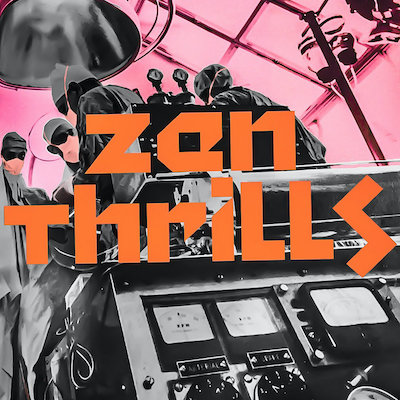The Mars Volta : The Mars Volta

It has been just over a decade since Noctourniquet, the last LP from The Mars Volta, and in that intervening time a lot has changed, not just within the band but within the broader world. The group dissolved with a non-zero amount of animosity after that last LP, never having toured behind it. Their vocalist and his family joined the Church of Scientology, something not unheard of in musical spaces and which has a long track record of causing tension between members and non-members. The very same vocalist and his family would later press charges against the church and Danny Masterson for… some egregious things you can google on your own. Add on to this the shifting directionality of Cedric Bixler-Zavala and Omar Rodriguez-Lopez, the aforementioned vocalist and the latter bandleader/guitarist.
Noctourinquet was the apex of a long-tail of musical changes. The debut EP and those first three studio LPs from the group seeing them establish ever longer and ever more internally complex and virtuosic pieces of psychedelic/progressive music, with live performances often pushing certain tracks into the half-hour mark. From The Bedlam in Goliath forward, however, the group was in a slow process of contraction, curbing track lengths and increasing the internal layering of their sonic palette until, by Noctourinquet, they had produced a slime-slick and queasy prog-pop record, fusing the internal knottedness of groups like Gentle Giant and Cardiacs with the squealing avant-garde of synthetic sound design that was the cutting age for 2012. Even after their dissolution of The Mars Volta, this process continued, with the paired-down art rock of Antemasque and that debut LP as well as the brief and exciting return of At the Drive-In. Then, all of a sudden, a light for the faithful: a strange black box, a Los Angeles-based Kaaba, inside of which played a mysterious flicker of song which, in the weeks that followed, was revealed to be the debut single of a forth-coming return LP from The Mars Volta.
I will admit, as a long-time fan (going back just over 15 years now), I was excited and then, just as suddenly, incredulous. They had released shorter pieces of music as singles before, trim and tidy 3-5 minute cuts, but the album versions would reveal these to have been massively trimmed down edits, sometimes lopping off up to 10 minutes of material. Not so in this case; the tracklist reveals the ugly truth, that only two songs crest over the four-minute mark and those by only a hair. What happened? Where went the band that I had loved? And this mellow, almost pulseless sound. I was upset. Even a delay in receiving the promo didn’t hurt me too bad. I was scared to play the album, to be honest, worried that it would be a case of a group returning to shoot rounds into the corpse of their legacy. So, on release day, I breathed a heavy sigh, crossed my fingers, closed my eyes, and pressed play.
The album is damn good.
It turns out, sometimes, that these pivots are signs of maturity, real maturity, and not some shallow attempt at capturing a market that was never theirs. The sounds here are undeniably the Mars Volta; wafts of Santana’s fusion era combined with the adventure rock of prog at its best, but now reined in and driven with the same precision as prog-pop artists like Supertramp, Prefab Sprout and David Sylvian’s solo years.
In retrospect, this makes sense. Prog itself has evolved over the past decade, no longer fearing pop or songcraft or approachability. The strains of post-hardcore, whose open embrace of prog has stretched now for a few decades and has had recent highlight with the return records of groups like City of Caterpillar and Gospel, still waft in here, but less so in furious energy and more in sound design. Because post-hardcore too has been evolving its sonic palette, with groups like The Armed producing cavalcades of post-industrial tuned noisescapes wielded toward approachable hooks. A few songs here feature sequencers, pulsing electronic beats, which we would not have expected to pass unmolested on previous Mars Volta LPs but in 2022 feel de rigeur. It’s a surprise; a pleasant one.
This isn’t to say the album is flawless. There are times where it drags, certain songs turning toward a clear melodic hook that doesn’t quite work or is placed against a somewhat chintzy progression behind it. In terms of overall accomplishment, this record still places itself well below most of the discography of this esteemed group. But, more importantly, it feels like an opening door.
Gambles like these don’t have to land the very first time; artists are allowed to build and develop over time, to assemble the ideas and test out the approaches. I am a lifelong fan of this group; that said, they hadn’t felt exciting to me from my ho-hum response to The Bedlam in Goliath to the lead-up to Noctourinquet. Only the album previous to this sparked my sense of intrigue and wonder again, eyes gleaming at the sight of these contracted and internally complicated songs; this sense of wonder is only underscored by this record, which shows that the group has the guts and the ability to pull out these elements which fans had always known were there but non-fans often couldn’t hear.
To someone who’s been with this group for a while, none of the moves here will be new, just their prominence. But seeing avowed non-fans of this group have their intrigue sparked, finally, after literally decades of the band’s existence, by the material presented here—It verifies something. This is something worth being excited about. Sometimes, that’s better than turning in a quality record of otherwise similar material.
Label: Clouds Hill
Year: 2022
Buy this album at Turntable Lab
Similar Albums:
Langdon Hickman is listening to progressive rock and death metal. He currently resides in Virginia with his partner and their two pets.




